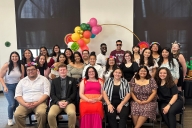You have /5 articles left.
Sign up for a free account or log in.

Istockphoto.com/MissTuni
SEATTLE -- The Whiting School of Engineering at Johns Hopkins University has since 2008 launched 351 new online master’s degree courses across 21 programs. Slightly more than 100 of those courses have been redeveloped or refreshed since their inception.
At first, the school planned to redevelop courses on a three-year cycle, according to Paul Huckett, assistant dean of learning design and innovation in the engineering school. During a session last Thursday at the University Professional and Continuing Education Association’s annual conference here, Huckett jokingly called that approach, in retrospect, “an absolute lie.”
“We were never going to complete that. It was impossible,” Huckett said. “We’ve adjusted that a wee bit.”
The new process involved establishing a comprehensive database that includes detailed information on each existing course: when it was first developed and launched, how many times it has been offered, who has taught it. The next step was a “redevelopment prioritization list.” Older courses and core courses, as well as courses cross-listed within several programs, get bumped higher on the list. Department chairs can also propose courses that need another look.
Administrators assign instructional designers to redevelopment efforts and compensate them for their efforts according to four tiers, from a two-month touch-up to a full overhaul. Instructional designers collaborate with instructors, who submit their finished courses to administrators for a final round of tweaks.
“We worked previously with a sledgehammer approach,” said Nathan Graham, director of the Center for Media and Digital Initiatives in the engineering school. “Now we use a scalpel.”
As “Inside Digital Learning” has reported, institutions invest considerable resources in creating online courses and ensuring they don't get stale -- updating technology, refreshing content, adjusting activities, improving digital accessibility. As online programs grow, institutions have begun systematizing what used to be largely ad hoc efforts.
The engineering school at Johns Hopkins managed to find a model that worked. Not every institution is successful as quickly. When administrators at the University of Maryland University College decided to implement a redevelopment process, they quickly realized they’d bitten off more than they could chew.
From a list of 120 courses with a low success rate and high enrollment, administrators selected 20. After six weeks of review, that list got narrowed again to 10. Even with the smaller scope, successfully revamping those courses with the process they’ve developed would have required 3,655 hours and eight and a half full-time staff members.
“We did this and said, ‘No way,’” said Gretchen Jones, UMUC's associate dean of curriculum and programs. “This approach was just not scalable.”
Since then, faculty members have gotten a little more involved in the “course discovery” process, as opposed to ceding responsibility to administrators or the accessibility team. Department chairs develop templates for new courses, and faculty members create within those.
Administrators there are still looking for ways to shorten the amount of time to develop a new course, which currently takes 23 weeks on average.
UMUC was founded to serve adult learners; online education has become a substantial component of its DNA. More traditional universities, in some ways, have a steeper hill to climb.
Until two years ago, Tulane University in Louisiana had a faculty-driven model for online course development, which meant “no one was leading or directing online education,” according to Ilianna Kwaske, associate dean of academic affairs in Tulane’s School of Professional Advancement.
Close to 70 courses emerged under that model, but their quality varied widely, Kwaske said.
Meanwhile, the school’s dean pressed for more online programs to compete in a growing market. Kwaske hired David Dumonde, previously an instructional designer at the University of Houston, Clemson University and elsewhere, to impose some structure on the process.
Instructors now enroll in a 12-week hybrid course in which they develop an online course alongside and in collaboration with their peers and an instructional designer, who leads the course. Modules include a detailed look at the learning management system’s capabilities and a primer on creating videos and other media.
Subject-matter experts took some time to adjust to learning new skills and getting guidance on how to teach, according to Dumonde. “The first program was really bloody,” he admits. The interactions have been more pleasant with more “prework” developing learning objectives and a course framework with subject-matter experts, Kwaske said.
All of these efforts will likely morph again as relationships between departments change and the pace increases further. The biggest challenge, according to Beth Mulherrin, assistant vice provost at UMUC, is embracing uncertainty.
“You often have a mandate to accomplish something very quickly,” Mulherrin said. “Sometimes you end up in a very different place than where you started.”








